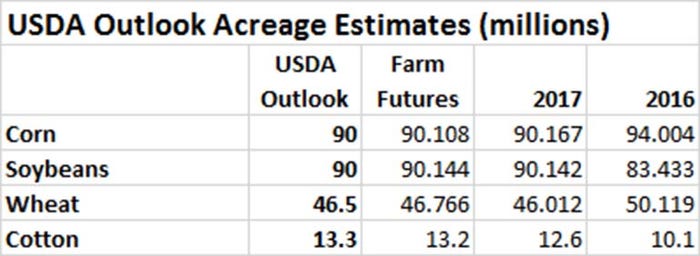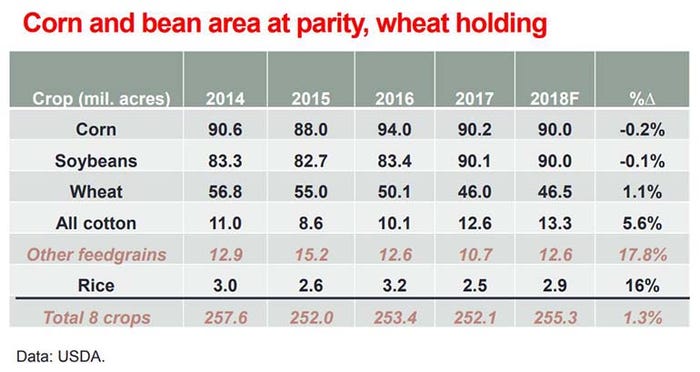
With snow still blanketing significant portions of the Northern Plains and upper Midwest, planting season may seem ages away – but in reality, it is just several weeks around the corner.
Another sign of the upcoming 2018 crop season came today from Arlington, Va., where USDA released its first planting estimates of the year at its annual Agricultural Outlook Forum.
The agency predicts robust corn and soybean acres, but they aren’t expected to surpass record acreage from recent years, says USDA chief economist Robert Johansson, speaking at the event.

USDA expects roughly equal corn and soybean acres in 2018, Johansson says, with each landing at 90 million acres. That’s 0.2% lower than a year ago for corn and 0.1% lower for soybeans. Wheat acres, on the other hand, are projected to rise 1.1% in 2018 to 46.5 million acres.
Johansson adds that ‘King Corn’ is in danger of losing its crown very soon.
“We expect soybean acres to reach parity with corn in 2018 and move ahead going forward,” he says.

Contrast USDA’s figures with recent industry trade estimates, which were released the day prior. As many as 21 industry analysts – including Farm Futures – participated in this survey.
For corn, analysts gave an average guess of 90.12 million U.S. corn acres, with a range between 88.77 million and 92.5 million acres. Corn acres in 2017 clocked in slightly higher, at 90.167 million acres.
Analysts also offered an initial estimate of average corn yields totaling 173.3 bushels per acre this year, for a total production of 14.361 billion bushels. Farm Futures contributed estimates of 90.108 million acres, a yield average of 172.6 bpa and a total production of 14.288 billion bushels.
For soybeans, analysts suggested U.S. 2018 acres will total 90.69 million acres this year. Individual trade guesses ranged between 88.5 million to 92 million acres. If realized, acreage would top total 2017 U.S. soybean acres, which totaled 90.142 million acres.
Analysts also estimated average 2018 U.S. soybean yields and production, including an average yield of 48.8 bpa for a total production of 4.374 billion bushels. Farm Futures contributed estimates of 90.144 million acres, a yield average of 48 bpa and a total production of 4.291 billion bushels.
For wheat, analysts estimated an average guess of 46.38 million acres of wheat this year, which would come in slightly higher than 2017’s total of 46.012 million acres. Analysts also are expecting an average wheat yield of 46.6 bpa for a total production of 1.838 billion bushels for 2018. That includes Farm Futures estimates of 46.766 million acres, a yield average of 45.2 bpa and a total production of 1.734 billion bushels.

These outlooks are always beholden to three market drivers, Johansson adds – demand changes, supply changes and U.S. foreign policy.
“Improved global economic growth would draw more households into the middle-class boosting overall food demand,” he says. Similarly, trading agreements can open up new markets to US producers, which would also boost demand for U.S. products.”
On the supply side, weather conditions often seesaw overall production – both higher and lower. For example, this winter in South American has seen drought in Argentina pull down the soybean crop, while Brazil’s production got a boost from beneficial rains, Johansson says.
And Secretary of Agriculture Sonny Perdue once again pledged support regarding U.S. policies at the Agricultural Outlook Forum.
“I tell the American growers – if you grow it, we’re going to help you sell it,” he says.
About the Author(s)
You May Also Like






